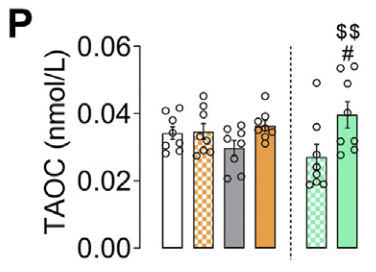Total Antioxidant Capacity (T-AOC) Colorimetric Assay Kit (ABTS, Enzyme Method)
SKU: E-BC-K219-M-500
Total Antioxidant Capacity (T-AOC) Colorimetric Assay Kit (ABTS, Enzyme Method)
| SKU # | E-BC-K219-M |
| Detection Instrument | Microplate reader (405-425 nm) |
| Detection method | Colorimetric method |
Product Details
Properties
| Synonyms | T-AOC |
| Sample Type | Serum, plasma, urine, saliva, tissue, cells |
| Sensitivity | 0.047 mmol/L |
| Detection Range | 0.047-1.50 mmol/L |
| Detection Method | Colorimetric method |
| Assay type | Quantitative |
| Assay time | 20 min |
| Precision | Average inter-assay CV: 4.100% | Average intra-assay CV: 2.200% |
| Other instruments required | Micropipettor |
| Other reagents required | Normal saline (0.9% NaCl), PBS (0.01 M, pH 7.4), 60% Ethanol |
| Storage | Reagent 5:-20℃, Others: 2-8℃ |
| Valid period | 12 months |
Images
J A Garcia-Partida et al investigate the effect of mango leaf extract for improving brain healthy situation. Total antioxidant capacity (T-AOC) in rat hippocampus was determined using T-AOC colorimetric assay kit (E-BC-K219-M).

T-AOC was significantly increased in C-RIS Group (light green bar). (P<0.05)
Dilution of Sample
It is recommended to take 2~3 samples with expected large difference to do pre-experiment before formal experiment and dilute the sample according to the result of the pre-experiment and the detection range (0.047-1.50 mmol/L).
The recommended dilution factor for different samples is as follows (for reference only):
| Sample type | Dilution factor |
| 10% Rat brain tissue homogenization | 1 |
| 10% Rat liver tissue homogenization | 1 |
| 10% Rat kidney tissue homogenization | 1 |
| 10% Epipremnum aureum tissue homogenization | 1 |
| Human serum | 1 |
| Human saliva | 1 |
| Human urine | 1 |
| Rat serum | 1 |
Note: When the sample was water soluble, the diluent is PBS (0.01 M, pH 7.4); When the sample is insoluble, the diluent is 80% ethanol.
Detection Principle
The principle of the ABTS method for determining the T-AOC is as follows. ABTS is oxidized to green ABTS+ by appropriate oxidant, which can be inhibited if there exist antioxidants. The T-AOC of the sample can be determined and calculated by measuring the absorbance of ABTS+ at 414 nm or 734 nm. Trolox is an analog of VE and has a similar antioxidant capacity to that of VE. Trolox is used as a reference for other antioxidant antioxidants. For example, the T-AOC of Trolox is 1, then the antioxidant capacity of the other substance with the same concentration is showed by the ratio of its antioxidant capacity to Trolox antioxidant capacity.
Kit Components & Storage
| Item | Component | Size 1(48 T) | Size 2(96 T) | Storage |
| Reagent 1 | Buffer Solution | 12 mL × 1 vial | 24 mL × 1 vial | 2-8℃, 12 months |
| Reagent 2 | ABTS Solution | 0.5 mL ×1 vial | 1 mL ×1 vial | -20℃, 12 months shading light |
| Reagent 3 | H2O2 Solution | 0.25 mL ×1 vial | 0.5 mL ×1 vial | 2-8℃, 12 months |
| Reagent 4 | Peroxidase | 0.1 mL ×1 vial | 0.2 mL ×1 vial | 2-8℃, 12 months |
| Reagent 5 | 5 mmol/L Trolox Standard | 0.3 mL ×1 vial | 0.6 mL ×1 vial | -20℃, 12 months shading light |
| Microplate | 96 wells | No requirement | ||
| Plate Sealer | 2 pieces | |||
Note: The reagents must be stored strictly according to the preservation conditions in the above table. The reagents in different kits cannot be mixed with each other. For a small volume of reagents, please centrifuge before use, so as not to obtain sufficient amount of reagents.
Technical Data:
Parameter:
Intra-assay Precision
Three human serum samples were assayed in replicates of 20 to determine precision within an assay (CV = Coefficient of Variation).
| Parameters | Sample 1 | Sample 2 | Sample 3 |
| Mean (mmol/L) | 0.12 | 0.58 | 1.20 |
| %CV | 2.5 | 2.3 | 1.8 |
Inter-assay Precision
Three human serum samples were assayed 20 times in duplicate by three operators to determine precision between assays.
| Parameters | Sample 1 | Sample 2 | Sample 3 |
| Mean (mmol/L) | 0.12 | 0.58 | 1.20 |
| %CV | 4.0 | 3.9 | 4.4 |
Recovery
Take three samples of high concentration, middle concentration and low concentration to test the samples of each concentration for 6 times parallelly to get the average recovery rate of 102%.
| Standard 1 | Standard 2 | Standard 3 | |
| Expected Conc. (mmol/L) | 0.15 | 0.33 | 0.75 |
| Observed Conc. (mmol/L) | 0.2 | 0.3 | 0.8 |
| Recovery rate (%) | 101 | 105 | 100 |
Sensitivity
The analytical sensitivity of the assay is 0.047 mmol/L. This was determined by adding two standard deviations to the mean O.D. obtained when the zero standard was assayed 20 times, and calculating the corresponding concentration.
Standard Curve
As the OD value of the standard curve may vary according to the conditions of the actual assay performance (e.g. operator, pipetting technique or temperature effects), so the standard curve and data are provided as below for reference only:
| Concentration (mmol/L) | 0 | 0.1 | 0.2 | 0.3 | 0.4 | 0.6 | 0.8 |
| Average OD | 1.921 | 1.735 | 1.555 | 1.392 | 1.224 | 0.873 | 0.543 |



